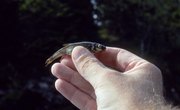
People have trapped, fished and hunted since the beginning of time, and they continue to do so. In some areas of the United States, especially in the South, people catch snapping turtles for their meat, which is a staple of Southern cuisine. During the dog days of summer, you can head for a pond or river in search of the turtles, which can get to be very large. Making your own snapping turtle lines is a simple process that requires very little cost or effort.
Items you will need
Empty detergent jug
At least 15 inches heavy-duty nylon line
Size 1 to 3 stainless steel fishing hook
Chicken gizzard or tough beef chunks
8-foot section 1/2-inch metal pipe
Medium-size utility hook
Making the Line
Attach at least 15 inches of heavy-duty nylon line to the empty jug by tying a knot around the handle of the jug.
Attach the stainless steel hook to the other end by using a standard fishing knot. You need to use a hook large enough to hold the bait, but small enough for the turtle not to notice.
Bait using the chicken gizzard or tough beef chunks, making sure to hide the hook. You need the turtle to swallow the entire hook in order to catch it; you don't want the turtle to strip the bait from the hook and leave.
Catching the Turtle
Go to your nearest pond and find an area where turtles are likely to hide. Farm ponds are your best bet, especially when the bottom is mud rather than stone. Look for water that is slow-moving or stagnant and murky.
Place the jug line where the water is between 12 and 18 inches deep. Keep to an area mostly free of snags; if the jug gets snagged on something, the turtle might be able to pull free. It there are a lot of snags, you can remove the jug and tie the other end to a branch that hangs over the water. You want the turtle to be able to tug a little bit, but not too much.
Check the bait daily, and add more bait or move the device as necessary. Don't let your traps go unchecked; this is cruel to the turtle. You cannot safely consume meat of a turtle that you find dead.
Attach the medium-size utility hook to one end of the pole if the turtle is hooked close to shore. Reach out and pull the hooked turtle to shore where you can pick it up. Use a sturdy fishing rod to pull in the line if the turtle is too far for you to reach.
Pick up the turtle carefully from behind by grabbing the shell just behind the back legs, where there is a small cavity, and place the turtle into a large plastic bin with water just deep enough to cover the back of the shell. You've successfully captured a snapping turtle.
Warnings
- Do not set traps on other people's property without their permission; it's illegal.
- Handle a snapping turtle with extreme care. It will bite you if it gets the chance, and it has very strong jaws. Its claws and tail can also cut you if you aren't careful picking it up.
Tips
- Check your state laws to see if you need any kind of license to trap turtles.
- Keep a stick with you to deter the turtle if it becomes aggressive once on shore. Rubbing the back of the turtle with the stick will be unpleasant and cause the turtle to attempt to escape from the sensation without harming it.
- June and July are when turtles are most active in the United States, so this is the best time to go trapping.
References
Tips
- Check your state laws to see if you need any kind of license to trap turtles.
- Keep a stick with you to deter the turtle if it becomes aggressive once on shore. Rubbing the back of the turtle with the stick will be unpleasant and cause the turtle to attempt to escape from the sensation without harming it.
- June and July are when turtles are most active in the United States, so this is the best time to go trapping.
Warnings
- Do not set traps on other people's property without their permission; it's illegal.
- Handle a snapping turtle with extreme care. It will bite you if it gets the chance, and it has very strong jaws. Its claws and tail can also cut you if you aren't careful picking it up.



